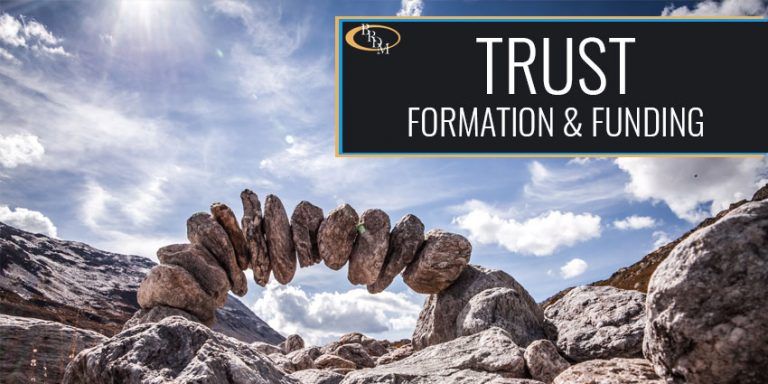When clients are deciding whether a Will or Trust best suits their estate planning needs, I always explain that Trust Planning involves two key steps:
Step 1: Forming the Trust, meaning deciding on its key terms and signing it into existence; and
Step 2: Funding the Trust.
What Does It Mean to “Fund” the Trust, and Why Is It So Important?
The main purpose of having any type of trust is to govern the administration of the property that is in the trust (or property that will be in it eventually). Because the trust only governs the assets that are in it, it is only as good as what it owns. An empty trust? Well, it may not do you much good. The most common type of trust in estate planning is called a Revocable Trust (also known as a Living Trust). The main purpose of a Revocable Trust is to avoid probate court proceedings when you die. Most of my clients want to avoid probate court administration because it is time-consuming and expensive. For many families, avoiding probate translates to tens of thousands, if not hundreds of thousands, of dollars saved for your beneficiaries. The truth is that if there is nothing in your Revocable Trust, then it is probably not doing you much good. Your estate planning attorney should ensure that an integral part of her representation is to guide you through the important, although sometimes tedious, process called “trust funding.” Essentially, trust funding means coordinating the majority of your assets with your Revocable Trust. Different categories of assets require different types of action. Here are some “rules of thumb” for funding your trust with some common asset categories:- Real Property – In Florida, attorneys refer to real estate as “real property.” This is probably the easiest type of asset to coordinate with your Revocable Trust, because generally all it takes is a quitclaim deed. However, the deed needs to be prepared correctly and recorded in the official records in the county where the property is located. If you are transferring your Florida homestead (i.e., your primary residence) to your Revocable Trust, then it is recommended that both the quitclaim deed and the trust document contain special verbiage reserving your homestead rights under the Florida Constitution; this ensures that the property appraiser does not disturb your existing homestead exemption and save-our-homes cap benefits when the deed to trust is recorded.
- Tangible Personal Property – Your estate planning attorney should prepare an assignment transferring your tangible personal property to your Revocable Trust. Examples of tangible personal property (“TPP”) include motor vehicles, boats and personal watercraft, household goods, appliances, furniture and furnishings, pictures, silverware, china, glass, books, clothing, and jewelry. Following your demise, your Successor Trustee can utilize the assignment of TPP, along with a copy of the trust document and your death certificate, to transfer your motor vehicles and marine vessels at the DMV without the need for probate court or other court order.
- Business Interests – Transferring business interests to your Revocable Trust can be accomplished with a relatively simple assignment prepared by your estate planning attorney. However, if your stock or membership units have transfer restrictions, then your attorney should assist you by obtaining permission from the company’s leadership to allow the assignment to the Revocable Trust. This is easy to do and seems to work with every company upon request.
- Regular Bank Accounts – When it comes to regular bank accounts, such as checking, savings and money market accounts, you have two options: make your Revocable Trust the owner of the account or the pay-on-death (“POD”) beneficiary of the account. Depending on the internal rules of your financial institution, making the Trust the owner (‘Plan A”) may be simple or complicated. If your bank fits the latter description, then “Plan B” is to make the Trust the POD beneficiary, which is typically just a matter of updating your beneficiary paperwork at the bank.
- Taxable Brokerage Accounts – Non-retirement investment accounts containing stocks, bonds, mutual funds and ETFs are also relatively easy to coordinate with your Revocable Trust. Once you execute your Revocable Trust, your estate planning attorney should send instructions that all taxable brokerage accounts should be re-titled into the name of the Trust. After this happens, the Trust is considered the owner of the account and thus avoids probate when you die (which is the whole point of your Revocable Trust in the first place). Additionally, if you become incapacitated, your “Successor Trustee” named in the trust document will have quick and relatively seamless access to the account assets and can communicate with your financial advisor freely on your behalf. All of the income tax attributes of the investment account will continue to flow through to you on your personal income tax return (IRS Form 1040).
- Tax-Deferred Accounts – Accounts that are “qualified” (by the IRS) or otherwise tax-deferred are treated differently by the IRS. You cannot make your Revocable Trust the owner of these accounts (by law), because they must be owned by an individual. Common examples of tax-deferred accounts include retirement accounts such as IRAs, 401(k) accounts, and 403(b) accounts. There are special steps that must be followed to properly coordinate these types of accounts with a Revocable Trust. If your beneficiaries are minors (under age 18 in Florida), inexperienced or bad with money, or suffer from an addiction issue, then it may be worth the extra effort to coordinate your tax-deferred accounts with your Revocable Trust. However, after the passage of the SECURE Act, for most clients it now makes more sense to name individual beneficiaries on their IRAs and 401(k)s. This is because most non-spouse beneficiaries are now required to withdraw the account assets over a mandatory 10-year period. If your beneficiaries are well-adjusted adults, this is a simpler option versus making the account payable to the Trust as an intermediary.
- Roth IRAs – Similar to Traditional IRAs, Roth IRAs can be made payable to a Revocable Trust provided certain tax requirements are met by including specific verbiage in the trust document. As with IRAs, the pros and cons of naming the Revocable Trust vs. naming individual beneficiaries should be discussed with your estate planning attorney.
- Life Insurance – It is simple to make your Revocable Trust the beneficiary of your life insurance policy. When you die, the insurance company will pay the death proceeds to your Successor Trustee, which can provide your Trustee with great flexibility and liquidity to pay any income or estate taxes that are due, property taxes and insurance, and generally to have cash available to meet the needs of your beneficiaries.



